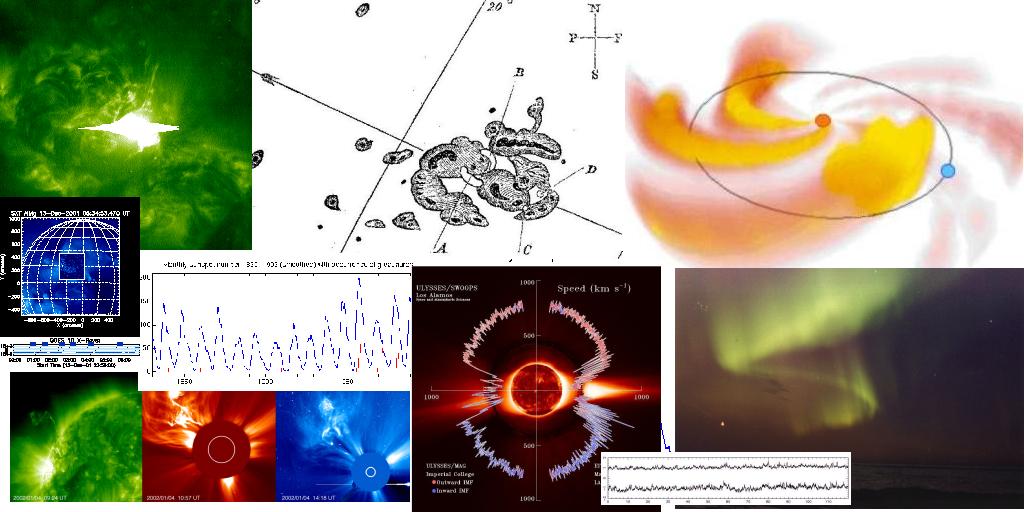
Solar-Terrestrial Physics from Carrington's flare to the future
Carrington 2000

Solar-Terrestrial
Physics from Carrington's flare to the future
Royal Astronomical Society G-meeting, 14th March 2003, Society of Antiquaries lecture theatre, Burlington House, Londonfile:///home/azb/Meetings/ras2003/carrington2k.png
In 1859 a spectacular white-light flare was observed, followed by aurora and large-scale magnetic disturbances on Earth, providing the first strong evidence that events on the Sun could be communicated directly to the Earth. March 2003 marks the start of the 2000th rotation of the solar equator since the white-light flare of 1859 - Carrington Rotation 2000 - and is therefore an appropriate time to review the state of the subject. What have we learned about Sun-Earth connections since Carrington's observations and what are the outstanding challenges for the future?
The meeting reviews the development of solar-terrestrial physics to the present day, discusses recent research highlights – we hope to see the first data from the new Solar Mass Ejection Imager, launched early this year, at the meeting – and sets out some of the outstanding challenges lying ahead in the run-up to the International Heliospheric Year.
Invited talks will cover the early development of STP (Dr. David Willis, RAL), the origins of solar variation in the solar interior (Dr. Bill Chaplin, Birmingham), Solar eruptive evens, flaring and mass ejections (Dr. Louise Harra, MSSL), the three-dimensional Solar Wind (Prof. Bernie Jackson, Univ. California, San Diego), CLUSTER and magnetosphere/solar wind coupling (Dr. Elizabeth Lucek, Imperial College), magnetosphere-ionosphere coupling (Dr. Eleri Pryse, Aberystwyth), modelling the disturbed ionosphere (Dr. Richard Balthazor, Sheffield), network analysis of complex data sets (Dr. Matthew Wild, World Data Centre) and the future UK strategy for STP (Prof. Alan Rodger). We invite contributed talks and posters, particularly from Ph.D. students and PDRAs.
Carrington 2000: RAS G-meeting, 14th March 2003
10:00-10:25 Registration and coffee:
10:25-10:30 Start and opening comments: Andy Breen, University of Wales, Aberystwyth
10:30-10:50 Historical STP data and their scientific importance: David Willis, Rutherford-Appleton Laboratory
10:50-11:10 The solar cycle: A helioseismological perspective: Bill Chaplin, University of Birmingham
11:10-11:20 Global coronal seismology using flare-generated waves: Istvan Ballai, University of Sheffield (contributed talk)
11:20-11:40 Flaring and eruptive events: Louise Harra, Mullard Space Science Laboratory, University College London
11:40-11:50 Results from RHESSI: Eduard Kontar or Alec MacKinnon (TBC), University of Glasgow
11:50-12:10 STEREO – a new perspective: Richard Harrison, Rutherford-Appleton Laboratory
12:10-12:40 Heliospheric tomography with interplanetary scintillation data: Bernie Jackson, University of California, San Diego
12:40-13:00 Dynamic processes at the bow shock and magnetopause: new results from Cluster: Elizabeth Lucek, Imperial College
13:00-13:45 Lunch and poster session
13:45-14:05 Ionospheric footprints of magnetospheric processes: Eleri Pryse, University of Wales, Aberystwyth
14:05-14:25 Ionosphere-thermosphere coupling: Richard Balthazor, University of Sheffield
14:25-14:35 Tristatic Fabry-Perot Interferometer and EISCAT radar measurements: Eoghan Griffin, University College London
14:35-14:45 Long-period variation in the upper atmosphere: Martin Jarvis, British Antarctic Survey
14:45-15:05 Analysis of complex data sets in STP: Matthew Wild, World Data Centre
15:05-15:15 The future of UK STP: Alan Rodger, British Antarctic Survey
15:15-15:30 Discussion
15:30-16:00 Tea at the Geological Society, Burlington House
16:00 onwards: RAS Ordinary Meeting, Saville Row
Invited talks are listed in bold type.
Bernie Jackson will be giving one of the talks at the ordinary meeting – The Solar Mass Ejection Imager (SMEI) as a Imaging Photometer for Tomography.